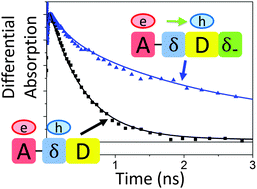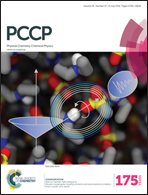Controlling charge separation and recombination by chemical design in donor–acceptor dyads†
Abstract
Conjugated donor–acceptor block co-oligomers that self-organize into D–A mesomorphic arrays have raised increasing interest due to their potential applications in organic solar cells. We report here a combined experimental and computational study of charge transfer (CT) state formation and recombination in isolated donor–spacer–acceptor oligomers based on bisthiophene–fluorene (D) and perylene diimide (A), which have recently shown to self-organize to give a mesomorphic lamellar structure at room temperature. Using femtosecond transient absorption spectroscopy and Time-Dependent Density Functional Theory in combination with the Marcus–Jortner formalism, the observed increase of the CT lifetimes is rationalized in terms of a reduced electronic coupling between D and A brought about by the chemical design of the donor moiety. A marked dependence of the CT lifetime on solvent polarity is observed, underscoring the importance of electrostatic effects and those of the environment at large. The present investigation therefore calls for a more comprehensive design approach including the effects of molecular packing.


 Please wait while we load your content...
Please wait while we load your content...